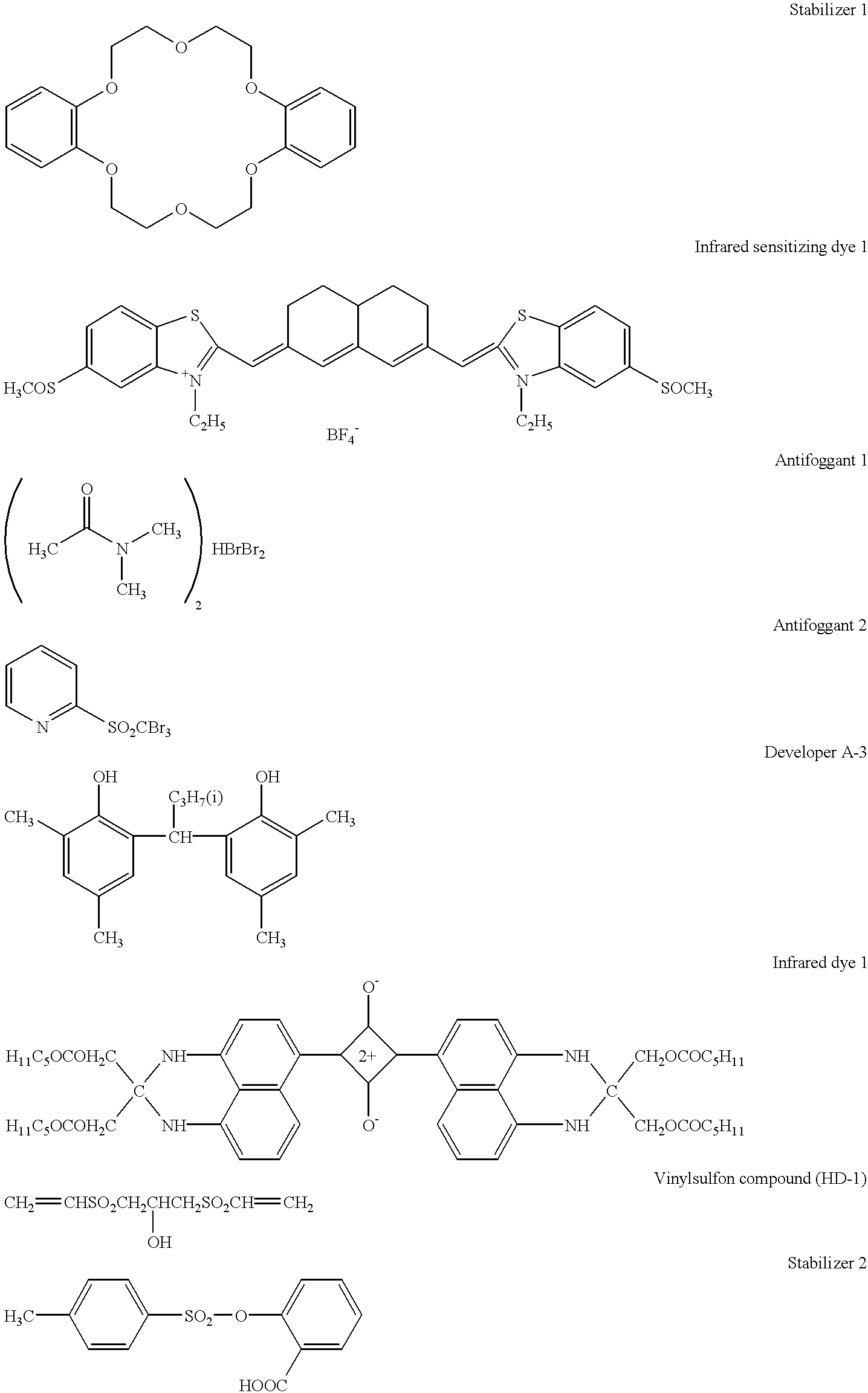Photothermographic material and image forming method
a technology of photothermographic materials and image forming methods, applied in the field ofgraphic arts and medical treatment, can solve the problems of reduced sensitivity, increased fogging, deterioration of image quality, etc., and achieve the effect of promoting adsorption and enhancing sensitivity
- Summary
- Abstract
- Description
- Claims
- Application Information
AI Technical Summary
Benefits of technology
Problems solved by technology
Method used
Image
Examples
example 1
[0152] Preparation of light sensitive silver halide emulsion 1
[0153] Solution A1
[0154] Phenylcarbamoyl gelatin 88.3 g
[0155] Compound (A) (10% methanol solution) 10 ml
[0156] Potassium bromide 0.32 9
[0157] Solution B1
[0158] 0.67 mol / l Aqueous silver nitrate solution
[0159] Solution C1
[0160] Potassium bromide 51.55 g
[0161] Potassium iodide 1.47 g
[0162] Water to make 660 ml
[0163] Solution D1
[0164] Potassium bromide 154.9 g
[0165] Potassium iodide 4.41 g
[0166] Iridium chloride (1% solution) 0.93 ml
[0167] Solution E1
[0168] 0.4 mol / l aqueous potassium bromide solution Amount necessary to adjust silver potential
[0169] Solution F1
[0170] Aqueous 56% acetic acid solution 16 ml
[0171] Solution G1
[0172] Anhydrous sodium carbonate 1.72 g
[0173] Water to make 151 ml
[0174] Compound (A) HO(CH.sub.2CH.sub.2O).sub.n,--(CH(CH.sub.3)CH.sub.2O).-sub.17--(CH.sub.2CH.sub.2O).sub.mH (m+n=5 to 7)
[0175] Using a stirring mixer described in JP-B 58-58288 and 58-58289, 1 / 4 of solution B1, the total amount of solutio...
example 2
[0210] Photothermographic material samples were prepared similarly to Example 1, provide that in the process of preparing the light sensitive silver halide emulsion, the amount of phenylcarbomoyl gelatin in solution Al was varied as shown in Table 3. The thus prepared samples were evaluated similar to Example 1 and the results thereof are shown in Tables 4 and 5.
3TABLE 3 Gelatin Content Av. C.V. Emul- Mixing of Grain of sion Temp. Nucleation Solution Size Grain [100] Gelatin No. (.degree. C.) Time Al (g) (.mu.m) Size*.sup.1 Face Content 8 45 4 min 45 sec 71.2 0.058 12% 92% 34.0 9 45 1 min 11 sec 71.2 0.048 12% 92% 34.0 10 45 24 sec 71.2 0.040 12% 92% 34.0 11 38 24 sec 71.2 0.030 12% 92% 34.0 12 47 4 min 45 sec 71.2 0.068 12% 92% 34.0 13 45 15 min 71.2 0.076 12% 92% 34.0 14 47 15 min 71.2 0.080 12% 92% 34.0 15 45 4 min 45 sec 41.3 0.058 12% 92% 19.8 16 45 1 min 11 sec 41.3 0.048 12% 92% 19.8 17 45 24 sec 41.3 0.040 12% 92% 19.8 18 38 24 sec 41.3 0.030 12% 92% 19.8 19 47 4 min 45 sec ...
example 3
[0214] Photographic material samples were prepared similarly to Example 2, provide that silver halide emulsions Nos. 8, 10, 15 and 17 were evaluated similar in Table 6. The thus prepared samples were evaluated similar to example 2 and results are shown in Table 6.
6TABLE 6 Image Av. Gelatin Raw Lasting Sam- Emul- Grain Content *.sup.3 Sensi- Image Stock Quality ple sion Size (g / mol AgX AgX / Org. Binder tometry Qual-Stabil- Image Re-No. No. (.mu.m) Ag) (g)*.sup.1 Ag*.sup.2 (g) Fog S ity ity .DELTA.Fog Color mark 50 8 0.058 34.0 16.5 5.77 .times. 10.sup.15 0.63 0.05 90 2 0.05 0.04 3 Comp. 51 10 0.040 34.0 16.5 1.76 .times. 10.sup.16 0.68 0.02 140 4 0.02 0.01 5 Inv. 52 15 0.058 19.8 16.5 5.77 .times. 10.sup.15 0.40 0.06 100 1 0.05 0.04 3 Comp. 53 17 0.040 19.8 16.5 1.76 .times. 10.sup.16 0.40 0.08 120 1 0.11 0.09 2 Comp. 54 8 0.058 34.0 82.4 2.88 .times. 10.sup.16 3.40 0.05 85 4 0.15 0.11 2 Comp. 55 10 0.040 34.0 82.4 8.79 .times. 10.sup.16 3.40 0.05 90 4 0.12 0.09 1 Comp. 56 15 0.058 19...
PUM
| Property | Measurement | Unit |
|---|---|---|
| average equivalent sphere diameter | aaaaa | aaaaa |
| average equivalent sphere diameter | aaaaa | aaaaa |
| grain size | aaaaa | aaaaa |
Abstract
Description
Claims
Application Information
 Login to View More
Login to View More - R&D
- Intellectual Property
- Life Sciences
- Materials
- Tech Scout
- Unparalleled Data Quality
- Higher Quality Content
- 60% Fewer Hallucinations
Browse by: Latest US Patents, China's latest patents, Technical Efficacy Thesaurus, Application Domain, Technology Topic, Popular Technical Reports.
© 2025 PatSnap. All rights reserved.Legal|Privacy policy|Modern Slavery Act Transparency Statement|Sitemap|About US| Contact US: help@patsnap.com



